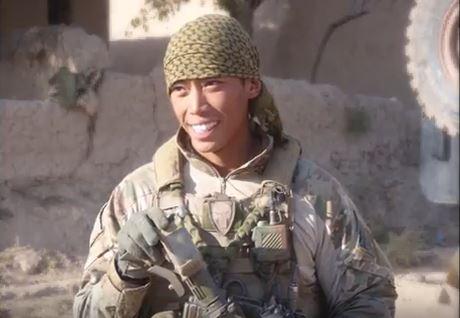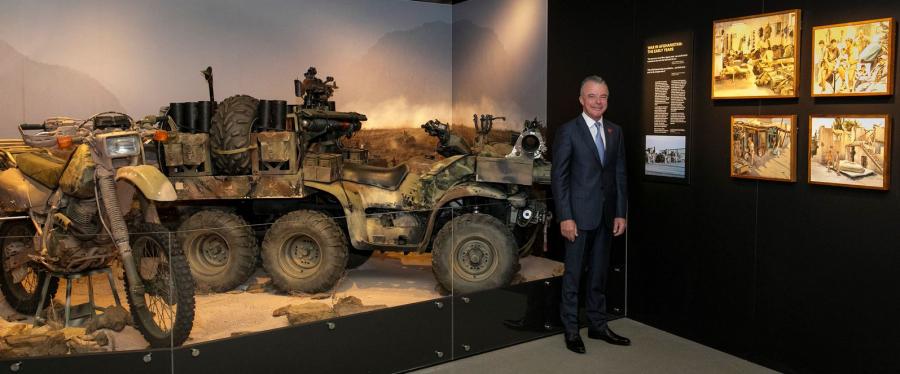From the shadows

Corporal Albert Trinh: "I just kind of looked up and thanked whoever, or whatever, was looking after me.”
Corporal Albert Trinh was serving with the 2nd Commando Regiment in Afghanistan when he heard someone saying one or two words in Pashtun.
“A dark shadowy figure had kind of popped around the corner and, just as I caught sight of him, he’d let a burst of AK off, maybe five or six rounds, straight through the team,” Trinh said.
“Initially two or three rounds had hit me, and I just remember seeing sparks kind of fly off my weapon, and I guess the blast force kind of hit me in the arm and the face, and it knocked me to the ground.
“I just remember the team commander … he’d been struck too … [and] both [of us] just getting on our guts and leopard crawling into a doorway … then immediately turning around and I guess trying to … return fire and see where he’d come from. But he’d already … disengaged and moved off into another position.
“Obviously I’d been shot, but I just didn’t know how bad it was.”
Trinh joined the regiment to give back to the country that he thought had given so much to his family. His parents had escaped by boat from Vietnam – they were raided by pirates twice, their compass and rudder broke – and Australia took them in.
Trinh became to be considered “unkillable” in Afghanistan, narrowly escaping death four times, once after stepping on an improvised explosive device (IED).
“I just remembered hearing a loud bang and I guess what felt like a sledge hammer hitting me on the bottom of my foot,” he said.
“I looked down and saw what looked like two metal tin containers that had been flattened out as contact pieces and a whole bunch of, I guess, wires and it was obviously an IED … the initiator had detonated, but the main charge had not, and I guess I just kind of looked up and thanked whoever, or whatever, was looking after me.”
Trinh’s story is one of the many being told as part of a ground-breaking new exhibition, From the Shadows: Australia’s Special Forces, at the Australian War Memorial.
Featuring more than 600 objects – from uniforms, weapons and vehicles used in the field, to terrain maps and gallantry awards – the new exhibition focuses on the history and ongoing work of Australia’s Special Forces from the Second World War to Afghanistan. It includes objects and stories from the Special Air Service Regiment, the 1st and 2nd Commando Regiments, and the Special Operations Engineer Regiment.
The identities of the personnel are protected, their activities are classified and their missions are secret, but the Memorial was given unprecedented access to tell their stories in the From the Shadows exhibition.

Dr Brendan Nelson: "They can’t tell their story, but we can tell their story, and we have a responsibility to tell it."
Memorial Director Dr Brendan Nelson said the exhibition was the first of its kind to tell the stories of the men and women who serve in Special Operations Command.
“They can’t tell their story, but we can tell their story, and we have a responsibility to tell it,” Dr Nelson said.
“As we go about our day-to-day lives, we have no idea that there is a small group of Australians … risking their lives and doing the most remarkable things.
“Some of them have said me, ‘I never thought I’d end up in a museum and part of a display – and if I did, I’d be dead.’”
Dr Nelson said it was important Australians recognised Special Forces and the work that they do.
Special Operations Forces can insert themselves into any environment undetected, by land, sea, or air, and have been continuously deployed at home and abroad for nearly two decades, being awarded honours in Afghanistan, fighting in Iraq, helping establish security in East Timor, and performing counter-terrorist roles in Australia and supporting domestic security agencies.
Dr Nelson said the Memorial had gone “as close to the edge” as was possible without breaching security.
“This is a very sensitive exhibition and we’ve worked hand-in-glove with Special Operations Command … to bring this exhibition to light,” Dr Nelson said. “I want[ed] this [exhibition] to be crammed with objects, items and anecdotes … to reveal not only the operations that have been undertaken by our Special Forces, but the character of the men who are behind them.”

Co-curators Dr Karl James and Danielle Cassar.
Award-winning journalists Chris Masters and Max Uechtritz produced compelling interviews with soldiers and their families, while Memorial historians and curators travelled across the country, visiting bases, viewing regimental collections and talking to serving personnel.
Senior historian and exhibition co-curator Dr Karl James said it was a privilege to work on the exhibition and to work so closely with Special Operations Command and the soldiers and their families.
“We spent a lot of time visiting the regiments, talking to the servicemen and women and finding out what they thought was important in telling their story,” Dr James said.
“What really came across to me is how modest many of these men and women are, as well as the fact that they want to recognise the team.
“Sergeant D received the Star of Gallantry in 2010, and when he presented these items for loan, they were in a plastic bag. There was a shot up aerial and a shot up Camelbak, and he just said, ‘I was just doing my job.’
“If we don’t tell these stories they will remain forever in the shadows and I think now is the time to think and reflect.
“It’s been our privilege to be able to show and display them here, often for the first time. What really came out is how important it was for us at the Memorial to tell their stories to the Australian public and really recognise their service and sacrifice.”
